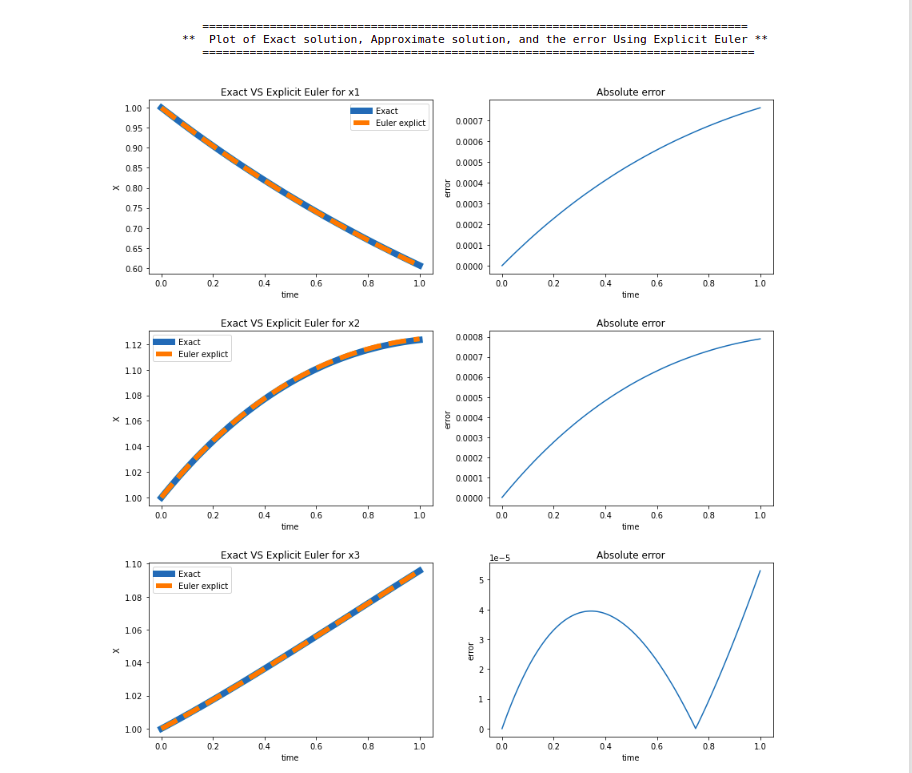Explict Euler method for Ordinary Differential Equations(ODEs) using Python
Theory
Let be a partition of
such that
and
be the constant length of the
-th subinterval
. Let us consider the initial value problem.
We can compute using the iterative equation.
And this iterative equation is called the Explict euler formula.
Implementation and Plots
Now let us see the implementation of explict euler formula using python.
"""
It takes partition boundaries-"a,b", the differential equation-"F", initial values-'c', and the step size-'h'
as argument and returns the numerical solution.
"""
def euler_explict(a, b, F, c, h):
N = int((b-a)/h + 1)
t = np.linspace(a, b, N)
y = np.zeros((len(t), len(c0)))
y[0] = c
for k in range(N):
y[k+1] = y[k] + h*F(y[k], t[k])
return y
Example
- Write code to solve the following system of ordinary differential equations
Subject to the initial conditions
- The exact solution of the above system of ODEs is given by
Let us implement the above system of ode and compire with the exact solution by plotting.
# import required libraries
import numpy as np
import matplotlib.pyplot as plt
from scipy.optimize import fsolve
from scipy.integrate import odeint
import warnings
warnings.simplefilter("ignore")
Define the exact solutions
x1t = lambda t : np.exp(-t*0.5)
x2t = lambda t : -2*np.exp(-t*0.5) + 3*np.exp(-t*0.25)
x3t = lambda t: 1.5*np.exp(-t*0.5) - 9*np.exp(-t*0.25) + 8.5*np.exp(-t*1/6)
Let us define a function to plot the solutions and the error.
def plot(time, exact, approximate, label, title, abs_er):
# plot for exact vs approximation
plt.figure(figsize=(16, 4))
plt.subplot(1,2,1)
plt.plot(time, exact, linewidth = 8, label="Exact")
plt.plot(time, approximate, linewidth = 6, linestyle='--', label=label)
plt.xlabel('time')
plt.ylabel('X')
plt.title(title)
plt.legend()
# plot for absolute error
plt.subplot(1,2,2)
plt.plot(time, abs_er)
plt.title('Absolute error')
plt.xlabel('time')
plt.ylabel("error")
Let us define the system of the differential equation
# defining the system of the differential equation
def model(x, t):
x1, x2, x3 = x
dx1dt = -0.5*x1
dx2dt = 0.5*x1 - 0.25*x2
dx3dt = 0.25*x2 - (1/6)*x3
return np.array([dx1dt, dx2dt, dx3dt])
And assigne the values of the parametrs and call our function.
a, b = [0, 4]
h = 0.01
c = np.array([1, 1, 1])
euler = euler_explict(a, b, model, c, h) # calling our function
x_e1 = euler[:,0]
x_e2 = euler[:,1]
x_e3 = euler[:,2]
Now let us plot it.
print()
print()
print("\t =================================================================================")
print(f"\t ** Plot of Exact solution, Approximate solution, and the error Using Explicit Euler **")
print("\t ==================================================================================\n")
plot(t, x1t(t), x_e1, 'Euler explict', "Exact VS Explicit Euler for x1", abs(x1t(t) - x_e1))
plot(t, x2t(t), x_e2, 'Euler explict', "Exact VS Explicit Euler for x2", abs(x2t(t) - x_e2))
plot(t, x3t(t), x_e3, 'Euler explict', "Exact VS Explicit Euler for x3", abs(x3t(t) - x_e3))

